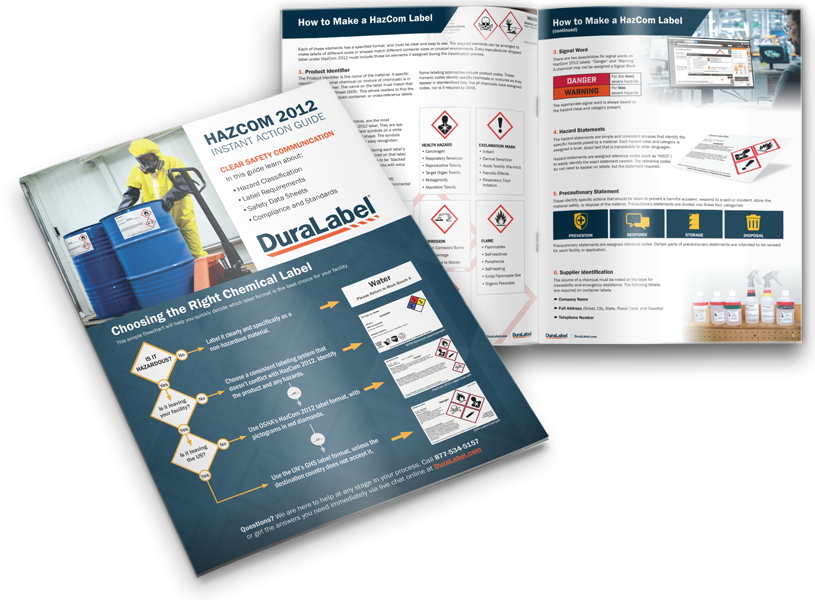Simple Tips for Workplace Chemical Safety

Pesticides, floor cleaners, hair dyes, medication ? chemicals are part of everyday life. Think about those innocent ads for cocaine in the early 1900s. Science has come a long way in knowing what chemicals can be beneficial to human life and what can kill it. Each year, manufacturers introduce about 2,000 new chemicals and mixtures for both home and work use, according to the U.S. Department of Health and Human Services' Toxicology Program. Working with chemicals safely is imperative. Within seconds, a chemical can penetrate skin or enter through the eyes, nose, or mouth. It's no secret that there are many workplace chemical exposures that have been linked to numerous ailments such as cancer, nerve damage, and blindness. Workplace safety and health managers in environments that work with chemicals can take several steps to protect employees and ensure safety.
Hazardous Results
Skin disease is the second most common type of occupational disease, according to the U.S. Bureau of Labor Statistics. However, the CDC says, "standardized methods are currently lacking for measuring and assessing skin exposures." Skin disease, poisoning, and respiratory conditions from hazardous chemicals cause millions of injuries or illnesses a year. The dangers of these chemicals present extreme safety challenges for workers and workplaces. There were 518 deaths from exposure to harmful substances or environments in 2016; 94 more than in 2015, according to the Bureau of Labor and Statistics.
More than 32 million workers (more than 20% of the entire U.S. workforce) are potentially exposed to hazardous chemical products in the workplace, the Occupational Health and Safety Administration reports. According to OSHA, about 650,000 chemicals are present in more than 3 million workplaces in the U.S. Hazard Communication (HazCom) Standard violations rank at No. 2 for OSHA's top 10 list in 2017 with 4,176 recorded offenses. OSHA's standard requires that:
- Manufacturers and importers evaluate the safety of chemicals they produce or import. Hazard information must be noted on chemical labels and in safety data sheets (SDS) for customers.
- Employers must provide compliant labels and SDSs for chemicals in the workplace to inform workers. Workers must also have training to help them understand the dangers of the chemicals with which they work and how to handle the chemicals safely.
This past July, a flooring manufacturer in New York was cited by OSHA and fined roughly $183,000 for violations that included exposing workers to chemical hazards. The company did not have a chemical communication plan in place.
"During this inspection, OSHA identified serious hazards that pose a threat to workers' safety and health," said Jeffrey Prebish, OSHA Syracuse Area Office Assistant Director. "Unfortunately, (the company) ignored its obligation to protect employees from these well-known issues."
Ways to Improve Chemical Safety
By minimizing chemical hazards, employers are already a step ahead in preventing potential exposure risks. Create a chemical safety plan that includes putting workplace prevention methods and chemical exposure protocols in place such as:
- Personal Protective Equipment: PPE can protect workers and chemical handlers by providing a barrier against those chemicals entering the body. Use a variety of chemical protective clothing, such as face shields, gloves, coveralls, and footwear to avoid chemical contact with skin, eyes, mouth, and nose. Remind workers to use PPE and create a PPE chart to help workers easily select the type of PPE best to use for specific tasks.
- Create a HazCom Program: Workplaces must not only have a program in place, but they must also keep that program up to date as tasks and processes change. Develop a written plan, training, an inventory of chemicals on site, and safety data sheets. Educate employees on the importance of hazard communication and SDS procedures. Include emergency response plans in case of chemical exposure.
- Prepare Health and Safety Stations: Highlight eyewash stations, fire safety equipment, first-aid stations and other areas that employees need to locate right away in an emergency through floor markings and signs. Organize cabinets with bold and clearly worded labels. Access the location of stations and consider how much ease an employee would have in finding these areas in an emergency, including a power outage. Also be sure employees know how to use items such as emergency equipment and eyewash stations or showers.
Employers and employees can eliminate the dangerous challenges that some chemicals present in the workplace. Develop a comprehensive program to protect workers from chemicals and use safety best practices that are in compliance.
Related Resources

The Importance of Chemical Risk Assessments
Chemicals are in use in workplaces every day. It is important to follow and maintain chemical safety for ...
Read
Tips for Better Chemical Safety Management
Workplace chemical safety is all about understanding the risks and following proper protocol. Train and ...
Read
HazCom Plans Crucial in Preventing Employee Exposure
Several workplace chemical exposures have prompted OSHA to remind companies of proper respirator and ...
Read.png)





